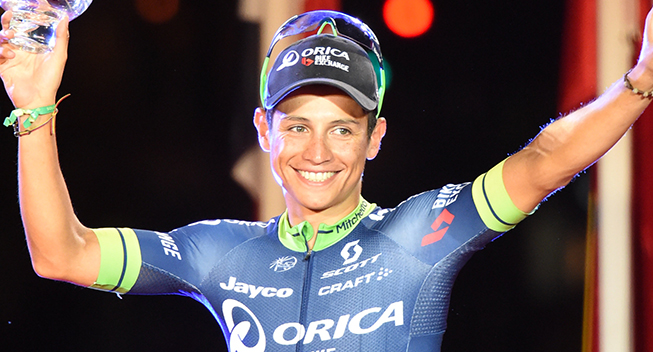The end of the cycling season is drawing closer but one of the most prestigious classics is still up for grabs. Being one of only five cycling monuments, Il Lombardia is a highly coveted race with a deep history and traditionally signals the end of the cycling year. A very hilly course makes it the toughest of the monuments and as it has been the case for the last few years, its new date has again made it attract a formidable line-up even though the race won’t have the feel of Worlds revenge match that it has had recently.
At this time of the year, it is usually hard for riders to stay motivated and most of the big names are mostly longing for a break at the end of what has been a long, testing season. However, the biggest climbers have one incentive to keep going all the way to the end: the chance to add Il Lombardia to their palmares.
The Italian race is joined by Milan-Sanremo, Tour of Flanders, Paris-Roubaix and Liege-Bastogne-Liege on the list of cycling's 5 monuments - the five most prestigious one-day races - and so a win in the Italian classic is a career-defining moment. Unlike its fellow monuments which are all spring races, Il Lombardia is held in the autumn. This is probably the main reason for the fact that the race is usually regarded as the least prestigious of the biggest races as it is held at a time when fewer riders are in peak condition and when the public interest in cycling is in decline.
While the race may be a little less coveted than its fellow monuments, it is the one that makes the climbers dream. Alongside Liege-Bastogne-Liege, it is the only monument that the stage race specialists and climbers can realistically target and with longer ascents than in Liege, it suits the real mountain goats better than the Belgian classic. This fact is reflected in the winners list which is loaded with Ardennes specialists and strong climbers.
While races like Sanremo, Roubaix and Liege are bound by their names and history to follow certain routes, Il Lombardia is much more diverse. Like Flanders, it is a tour through a certain region and this creates plenty of room for variation of the courses. The start and finishing cities and the courses have all varied a lot during the years and the race will never get any kind of fixed format. The only real signature symbols of the race are the Lake Como and the Madonna del Ghisallo climb. The steep ascent leads to the small church and a museum containing both religious and cycling objects and is one of the landmark climbs in professional cycling. While the climb is usually located too far from the finish to be the scene of the decisive attack, its toughness makes it a crucial place in any edition of the Lombardy race.
The race was first held in 1905 when it was known as Milan-Milan before being named Giro di Lombardia two years later. Since then, the race has been held every year, with 1943 and 1944 being the only exceptions. Until 1960, it started and finished in Milan but in 1961 the finish was moved closer to the hills in Como. Since then it has finished in Milan, Monza, Bergamo and Como before the finish was moved to site in Lecco for the 2011, 2012 and 2013 editions. The race has mostly started in Milan but has had several exceptions. The 2012 and 2013 editions started in Bergamo while Como played an unusual role as the starting city in 2014. After three years with identical finales and two years with very similar courses, the route was given a major overhaul for 2014 in what was probably the easiest version in recent years. Last year the race went in the completely opposite direction as the organizers designed the hardest course in several years. This year they have taken it one step further by creating a route that is almost similar to what you will find in a mountain stage at a grand tour and even though the race has the same rather easy finish in Bergamo that it had in 2014, it is a vastly different affair.
The race has been won by most of the biggest names in cycling, with Fausto Coppi holding the record with 5 wins. Surprisingly, Eddy Merckx has only triumphed twice and Sean Kelly and Henri Pelissier are the only non-Italian riders with three wins on their palmares. In recent years, the race has been dominated by Damiano Cunego, Michele Bartoli, Paolo Bettini, Philippe Gilbert and Joaquim Rodriguez who have all won the race at least twice, with the former rider being the only of them with three wins.
Due to its autumn date, the race is known as the ‘race of the falling leaves’ and is the crown jewel of the many Italian autumn classics that are held during the months of September and October. During the last three weeks, no less than 10 major races have been held in Italy and they can all be regarded as some kind of preparation for the big event. With a tough course and many riders being fatigued, it is often characterized by many withdrawals and often produces surprise results. At this time of the year, it is more about freshness than anything else.
Until 2012, the race was the final big European race of the season and many riders found it difficult to keep going from the World Championships until Il Lombardia. To attract bigger names and create synergy with the Worlds, the UCI restructured the calendar by moving the Italian classic to the weekend just after the global contest and postponing Paris-Tours to Il Lombardia's usual weekend. The shorter time gap should allow more riders to stay fresh and so add prestige to one of cycling's most important races. It may no longer signal the real end of the season but the start list has certainly been boosted by the move. Nowadays, it seems like all climbers that do the Worlds, postpone their off-season until after Il Lombardia. The synergy has been made even bigger by the fact that the 2012, 2013 and 2014 Worlds were all held on hilly courses, meaning that lots of climbers had been riding in the battle for the rainbow jersey. Until 2012, the race was held on a Saturday but in 2013 it was moved to the Sunday after the World Championships. For 2016, it is back in its usual Saturday slot.
This year the calendar has been changed completely due to the new dates for the Worlds and this has had an impact on Il Lombardia. Now the Worlds are held later than usual and as the flat course in Qatar bears very little similarity with the race in Italy, there is no kind of synergy between the two events and the number of riders doing both events is very small. That has prompted many climbers and grand tour riders to end their season prematurely and some are far from their best condition. On the other hand, the harder course has inspired others to keep going and with no Worlds, the monument has been the biggest goal for many for several weeks. The restructure of the calendar means that they have had three weeks of racing in Italy to get ready and the two big dress rehearsals, Giro dell’Emilia and Milano-Torino, have clearly indicated that many are on form. Riders like Fabio Aru, Romain Bardet, Rigoberto Uran, Julian Alpahilippe, Dan Martin, Rui Costa, Diego Ulissi, Tony Gallopin, Tim Wellens, Wilco Kelderman, Wout Poels and Bauke Mollema have carefully been building form for this race and Vuelta contenders Alberto Contador, Esteban Chaves, Simon Yates and Alejandro Valverde have all decided to keep going all the way to Lombardy.
Instead of being a Worlds revenge, the race plays another important role. With the Tour of Beijing having disappeared from the calendar, Il Lombardia is back in its former position as the final race on the WorldTour calendar. This means that it will decide the battle for the top honours in the season-long competition. As the top 3 riders, Peter Sagan, Nairo Quintana and Chris Froome, will all be absent, Sagan has already won the individual competition but the battle for the teams win will go down to the wire, with Movistar and Tinkoff both still in contention for a title that seems to have gained more prestige in recent years.
Last year an unusually hard course made for a very selective race where only the strongest were left in the finale. Vincenzo Nibali and Esteban Chaves seemed to be the strongest riders in the race and it was Nibali who attacked on a descent to take a solo win while Chaves was taken out by a hunger flat and cramps. Daniel Moreno took off in pursuit on the final climb and got close to Nibali in the end, ultimately settling for second place, while Thibaut Pinot completed the podium. Having just returned from injury, Nibali has opted to go to Kazakhstan for the Tour of Almaty and won’t defend his title but Moreno will be back as part of a strong Movistar team. Pinot has ended his season prematurely and will be absent too.
The course
As said, there is nothing fixed about the course for Il Lombardia which has changed several times over the years. Several times the race seems to have found its format but apparently organizers RCS Sport are keen not to have any kind of monotony and recognizability. Whenever the race has had the same finale for a number of years, the course is always given a major overhaul.
After three years with the finish in Lecco and the final climb of the Villa Vergano, the 2014 saw another change. The course was completely different from the one used in the latest editions and only the landmark climb of the Madonna del Ghisallo and the scenic run along the Lake Como provided the riders with any kind of familiarity. The rest of the course was completely new and both the start and finish had been moved. Bergamo which hosted the finish from 1995 to 2003 was again the scene of the arrival of the final monument of the season while Como was chosen as start city. However, the terrain around Bergamo is less hilly than the Como hills and so the edition was far less selective than it has been in the past.
Last year the trend was reversed and the 2015 edition was the hardest in recent memory. This time the race started in Bergamo and finished in Como and the amount of climbing was much greater than it had been one year earlier. Most notably, the brutally steep Muro di Sormano was a key moment in the race and made the peloton explode to pieces.
This year the organizers have taken it one step further and the 2016 edition will be even harder. The start and finish have again been reversed so as in 2014 the riders will start from Como and end in Bergamo. As said, the terrain around Bergamo is less hilly and this means that the final kilometres are relatively easy. Unlike in 2014, however, the organizers have made up for the easier finale by adding a huge amount of climbing earlier in the race and more than 4400m of climbing means that the race is like a mountain stage in a grand tour.
The new course can be divided into two parts. The first 120km are not overly difficult and only includes the landmark climb of the Madonna del Ghisallo which comes much earlier than usual and will be less decisive than it has been in the past. However, from the moment the riders hit the Valcava climb, hell breaks loose and from there five climbs follow in quick succession with not a single metre of flat roads in between. In the end, the terrain gets easier for the final 20km where the short cobbled climb of Bergamo Alta in the finale is the only obstacle.
At 241km, the race is a bit shorter than a typical monument. It will start in Como and from there the riders will head south along relatively flat roads before they will turn around and heads towards the Como Lake. Here they will follow the flat road long its shores for a few kilometres until they will again turn around and head into the hills to go up the famous Madonna del Ghisallo climb (8.58km, 6.2%, max. 14%). The top comes at the 64.7km mark and from there the riders will descend back to a the plains in the Po Valley where only the small Colle Brianza climb after 96km of racing will break the monotony. This early part of the race will be the scene of some very aggressive racing where the early break will be established. In past years, it has often been important to have teammates up the road and it is never a disadvantage if a few support riders can make it over the first climbs and provide some valuable assistance in the finale. However, the major teams are likely to mark each other closely and we should get a break of riders from some of the smaller teams.
After Colle Brianza, the riders will turn around and again head north as they go into the hills north of Bergamo. The race will start for real after 131.6km when the peloton will hit the bottom of the hardest climb of the race, Valcava, which averages 8% over 11.65km and reaches a maximum of 17%. The first part is not overly difficult, with a steady gradient of 7-8% but then things get very tough with a 4km section with a gradient of 11.6%. Only the final 600m are again a bit easier.
From this moment, there is no chance recover. After the descent, the riders will head straight onto the lowr slopes of the Berbenno climb (6.5km, 5.1%) and then it is time for the two novelties of the race, Sant’Antonio Abbandonato (6.5km, 8.9%, max. 15%) and Miragolo San Salvatore (8.7km, 7%, max. 11%). Both climbs are very regular with a relatively constant gradient but the first climb is steeper than the numbers show as the gradient is close to 10% for most of the time, with only the final kilometre being easier. The top of the latter climb comes at the 199.7km mark and the descent is followed by the easier Selvino ascent (6.9km, 5.4%, max. 9%) which is another very regular climb that never gets very steep.
This section with five climbs in quick succession is where the damage has to be done. If the climbers want to win the race, they have to attack from afar and make sure that only a very small group of contenders make it over the top of Selvino together. With the huge amount of climbing and strong teams eager to make the race hard, we can expect a gradual elimination race and only a select group will be left after the fifth climb. However, there is still a long way to the finish and it will be very difficult to make a race-winning solo attack, especially as Selvino is too easy to make a difference. Hence, it is very likely that a select group of climbers will emerge at the end of the hardest section of the race.
The top of Selvino is located with 28.3km to go and is followed by a long 12km descent back to the plains around Bergamo. The riders will hit flat roads with 16.3km to and from there they will travel in a southwesterly direction towards the finishing city. However, the race has a sting in its tail as the riders will hit the bottom of the Bergamo Alta climb (1700m, 7.9%, max. 12%) with 4.6km to. It includes a cobbled section of 200m and in the first part, the gradient doesn’t drop below 10%. After the top, the riders will face a gradual descent on a wide road with no major technical difficulties. However, there’s a difficult turn in a narrower section with 1800m to go. The road bends to the left under the flamme rouge and then the road flattens out for the final 500m. The final turn comes 250m from the line and from there the riders will hit the 8m wide, flat finishing straight.
The final part doesn’t include any major obstacles but it could still play a major role. If a small group has emerged, all the leaders may be isolated and this could open an interesting tactical battle in the flat run-in to the finish. That could open the door for a successful late move in one of the easier parts. If the group is still together, the final climb serves as a perfect launch pad for a late attack and even though the short ascent is pretty easy and didn’t do much damage when it was last used in 2014, things will be different at the end of 241 brutal kilometres. A lonely rider could very well make the difference here and on this couse there is no doubt that the winner will be one of the very best climbers. In the past, sprinting skills and punchiness have always been important skills in Lombardy and they are still very strong assets but this year Il Lombardia is likely to be a real race of attrition and a hugely selective affair that can be won by climbers and stage race specialists.


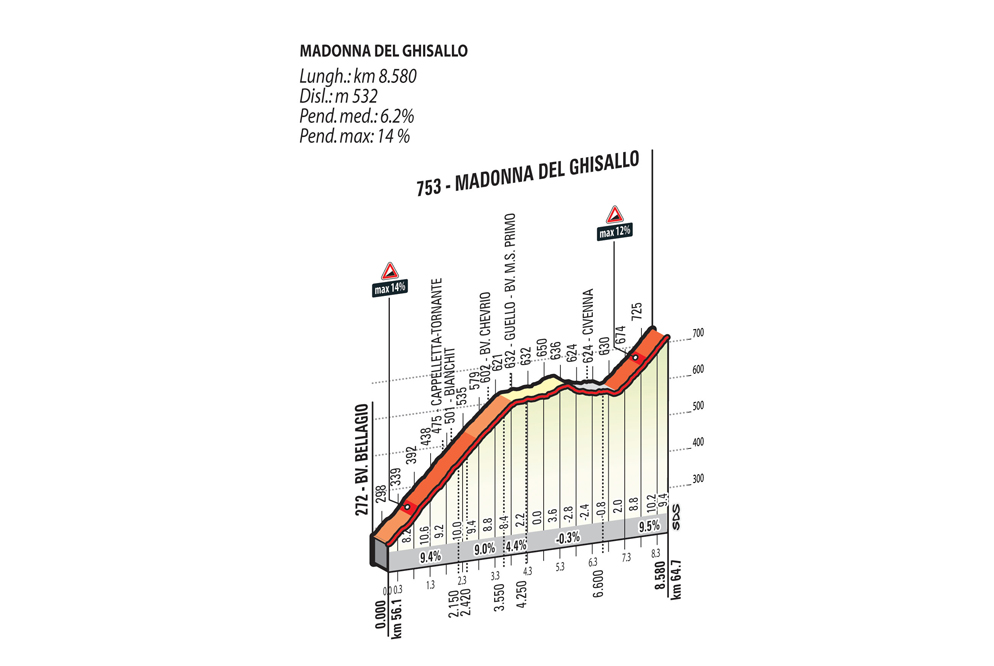
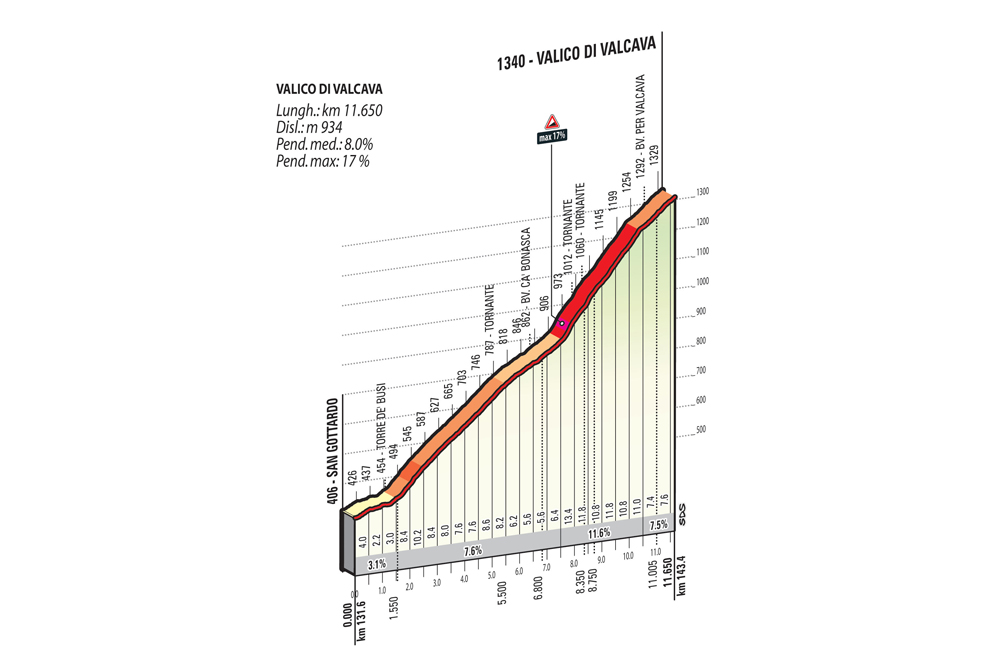
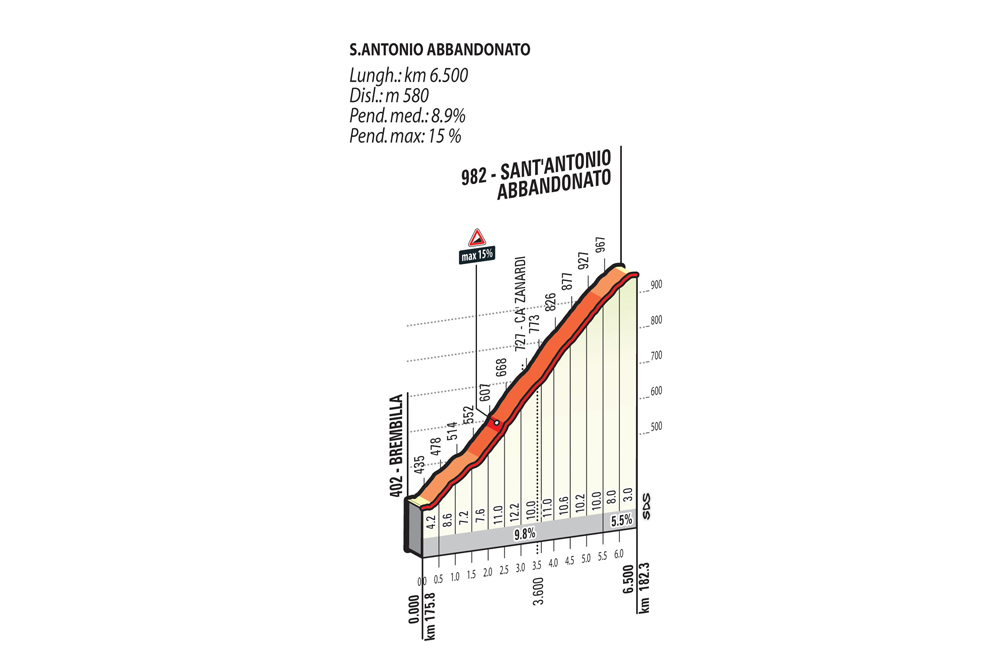
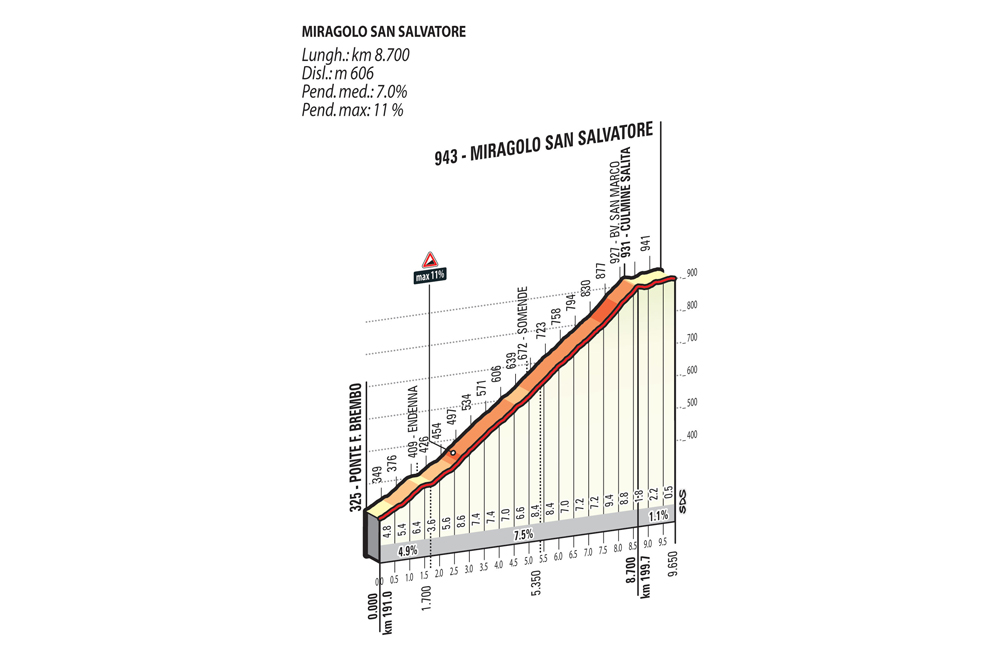
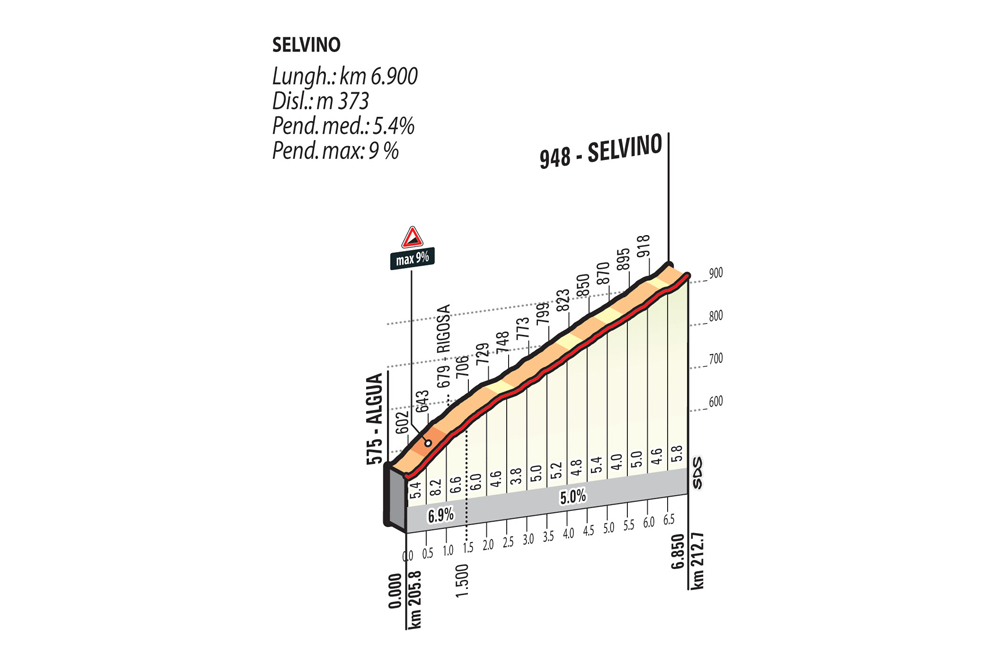
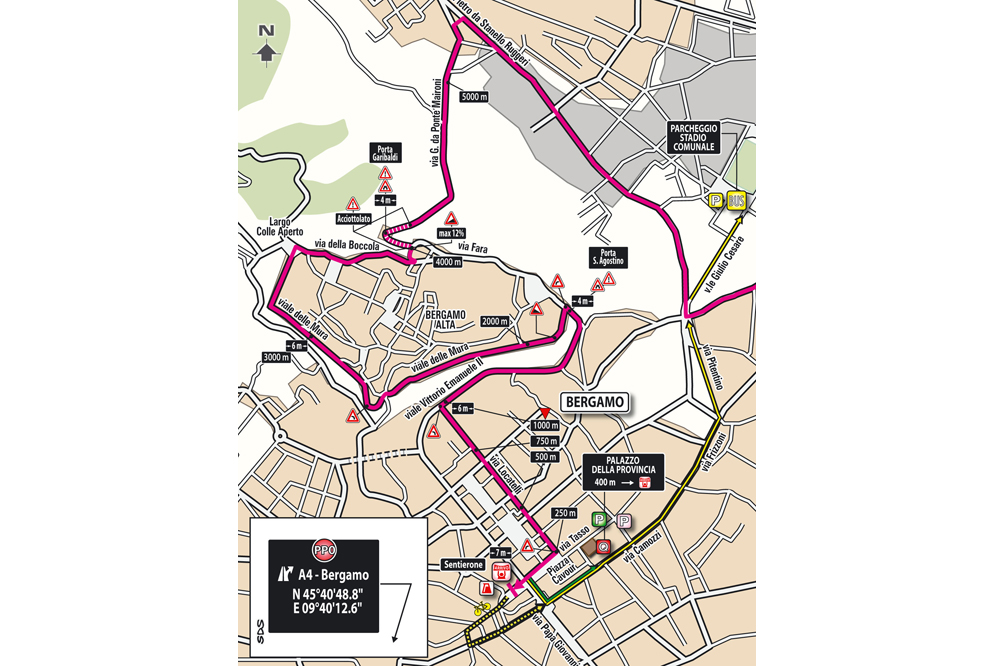

The weather
Many recent editions of Il Lombardia have been marred by bad weather – especially four years ago when there were no live images from the final climb. With its position as an autumn classic, it is no surprise that rain has often been an important factor. In bright sunshine, the views are stunning but very often we have been robbed the chance to watch the beautiful scenery.
This year it seems that we will have a relatively pleasant edition of Il Lombardia. There won’t be much sunshine as Saturday is forecasted to be a cloudy day but there is only 10% chance of a shower. The temperature will be around 22 degrees.
There will be a light wind from a southerly and southeasterly direction which means that the riders will mainly have a headwind or a cross-headwind. It will be a cross-headwind in the hilly zone and a cross-tailwind in the run-in to Bergamo. It will be a tailwind on the climb to Bergamo Alta and mainly a cross-headwind after the top.
The favourites
A new course always means a new dynamic and lots of uncertainty. While the few variations mean that races like Milan-Sanremo, Paris-Roubaix and Liege-Bastogne-Liege usually unfold in a pretty similar way, Il Lombardia’s varying nature means that it is the one that is hardest to predict. Furthermore, it makes it harder for the riders to make their strategy for the race as they know little about how the race will unfold.
Over the last few years, the old course had given the race an established format but in the last few years the revamped routes have thrown things up in the air and this year another alteration will make riders uncertain about what to expect. However, while the relatively easy course in 2014 made it a very tactical battle, things should be a lot clearer like they were in 2016. The brutally hard course means that this is a race for pure climbers and the legs will do the talking. Of course a strong team will always be an advantage but this race will be dominated by the best climbers who are still in form and motivated.
On the other hand, there’s a big difference between the two courses. Last year there were hard climbs very close to the finish and this meant that the strongest riders could make a difference. This year we have the same easy finale as we had in 2014 and this means that tactics can come into play after the top of the Selvina climb. At this point, the peloton is likely to be reduced to a very small group and many leaders will be isolated. Last year Vincenzo Nibali made his race-winning move on a descent and this year a small group may make a decisive difference in this flat section. If not, it should all come down to the final climb which didn’t make much of a difference in 2014 but this year the hard race should make it a lot more selective.
We expect the race to come to life on the Valcava climb. Astana, Orica-BikeExchange, Tinkoff and Cannondale want a hard race and we expect them to control things. The Russian team don’t really have the line-up to do much but especially Astana and Cannondale can do a lot of damage. Ag2r also have a strong team and may also take control. We expect their fast pace to turn the race into an elimination race.
Pure climbers like Fabio Aru, Romain Bardet and Alberto Contador can’t wait for the climb to Bergamo Alta so we expect them to make some moves already before Selvino. This will only make the race harder but we doubt that anyone will be able to make a solo move and maintain the advantage in during the flat run-in to Bergamo. We predict a small group to reach the flat section together and then the decisive moves will be made either in the flat section or on the final climb.
To win the race, you need to be an excellent climber to still be in contention after the climbs but luck will also be necessary if tactics come into play in the flat section. A good punch will be important on the final small hill in Bergamo and as it isn’t overly selective a good sprint is definitely not a disadvantage. Furthermore, a strong team could be vital if the race becomes uncontrollable in the flat run-in to the final climb.
At this point of the season, freshness and fatigue are the key factors and they are much more important than the top level of the riders. Luckily, the many one-day races that have been held in the build-up to this year’s race give up a much better indication of the form of the main contenders than we have usually had. Most of the riders have done at least one of the Italian one-day races and only Alejandro Valverde and Alberto Contador who have been recovering since the Vuelta are big unknowns.
Speaking about form, Esteban Chaves stands out as the favourite. The Colombian has done the Vuelta twice and every year he has come out of the race in outstanding form. In 2014, he played a key role at the World Championships and went on to take third at the Tour of Beijing. Last year he was maybe the strongest rider in Il Lombardia until cramps and a hunger flat took him out of contention and he went on to take overall victory at the Abu Dhabi Tour. It seems that the Colombian has an ability like nobody else to maintain his form after the Spanish grand tour and this year it is no different.
Chaves proved his condition when he won the Giro dell’Emilia with a great solo attack on the San Luca climb and he seemed to be at ease when he dropped in-form riders like Romain Bardet and Rigoberto Uran. Already last year he was strong in Il Lombardia and this year he seems to be on fire again.
Chaves is not a real classics rider and so he needs a very hard race to win. Hence, the tough course is great for him but the problem is that the climbs come a bit too early. He has a decent kick on a short climb but other riders are punchier than him and – more importantly – faster in a sprint. Furthermore, Simon Yates doesn’t seem to be in great form and so Chaves is likely to be isolated in the finale. That will make things difficult as many will be watching him closely.
Nonetheless, we will make Chaves our favourite. If it comes down to a battle from a small group on the climb of Bergamo Alto, it won’t be easy to follow Chaves. As said, other riders are punchier but they don’t have the form that Chaves has. As last year’s race showed, the distance could be a challenge but he has probably learned his lesson. At the end of a long, hard race, we doubt that anyone can match Chaves on the final climb and we predict him to take a solo win.
One of the other in-form riders is another Colombian. Rigoberto Uran has had a bad year but now the Colombian finally seems to have hit a golden vein of form. He was already strong in Canada where he was close to victory in Quebec before he headed o Europe. Here he showed his form when he finished third behind Chaves and Bardet in the Giro dell’Emilia. On Tuesday, he was the strongest rider in Tre Valli Varesine where he simply rode Gianluca Brambilla off his wheel on the final climb and on Wednesday he was again the best of the favourites on the Colle di Superga climb in Milan-Turin.
Uran is clearly in excellent condition and this year’s course suits him pretty well. He has been on the podium before and has won silver at the Olympics so he has proved that he can handle the distance. At the moment, he is one of the best climbers so he should benefit from the hard course. Furthermore, he is very strong and punchy on short climbs so the finale in Bergamo is great for him. To make things even better, he is very fast in a flat sprint and so he has the complete package. Finally, the Cannondale team is very strong and he could very well have riders like Michael Woods, Tom-Jelte Slagter, Davide Villella, Moreno Moser and Davide Formolo at his side deep into the race. That will make it easier to control things. The question is whether he can follow Chaves in the final climb. If he can, he will be hard to beat in a sprint as only Julian Alaphilippe, Alejandro Valverde and Dan Martin can match him in a flat finish.
The third in-form rider is Rui Costa who is another former podium finisher in the race. The Lampre-Merida rider has been absolutely flying since the Tour. He was the best on the climbs in Hamburg, Plouay and Canada where he dropped all the best climbers with a great attack in Montreal. He wasn’t far from winning that race and proved that he was the strongest rider. He was also good at the European Championships but that race was a bit too easy for him.
Costa used Milan-Turin as a warm-up but deliberately took it easy to save energy for Saturday. Hence, we can’t base too much on his poor result and we have little doubt that he will be firing on all cylinders in Lombardy. The course is not ideal for him as it may be a bit too hard. However, the climbs all come far from the finish and this means that there is a solid chance that he will make it over Selvino with the best. If he is still in contention at that point, he will be a danger man. He knows how to make a well-timed attack in the flat section and the climb to Bergamo Alta suits him down to the ground. Most notably, he is bigger than many of the lighter guys and so he is a lot more comfortable on the cobbles. Finally, he is fast in a flat sprint and as he can also handle the distance, he has all the skills to win this race.
Etixx-QuickStep have a three-pronged attack and this will make the Belgian team dangerous. Their best card is Julian Alaphilippe who just keeps impressing. Last year we would have regarded the course as being a bit too hard for him but this year there are no such concerns. He proved how he can handle the climbs at the Tour de France but more important he was one of the strongest – maybe even the strongest – at the Rio Olympics where the course was also very hard.
Alaphilippe has proved that he is still in good condition. He was not at his best in Canada but his class still allowed him to mix it up with the very best on the climbs. Only an outstanding Sagan managed to beat him at the European Championships and since then he has had his eyes on this race. He has proved that he can handle the distance and among the favourites, only Alejandro Valverde can match him in a sprint. The problem is the overall amount of climbing as he may come up short against the pure climbers and the cobbles in the finale could also be a challenge – just recall how he struggled on the rough surface in Liege earlier this year.
Movistar go into the race with a two-pronged attack. Daniel Moreno and Alejandro Valverde have both finished second in this race but they find themselves in different positions. Like last year Moreno has finished the Vuelta in great form. He has not been at his best in 2016 but now is on fire. Last year he finished second in Il Lombardia and this year he has already taken third at the European Championships and fourth in Milan-Turin. He is an accomplished classics rider who is suited to this course and the distance. The hardest climbs come far from the finish which is perfect for Moreno who is more suited to the punchy climb in the finale. Furthermore, he is one of the fastest in a sprint. The problem is his huge inconsistency but if he has the legs he had in Milan-Turin, he will be hard to beat here.
The best Ardennes rider in the world is Alejandro Valverde but surprisingly he has never won this race even though it suits him down to the ground. In the last few years, he has been the perennial favourite but this year things are different. Valverde has had a brutal year with three grand tours and everybody could see how tired he was at the end of the Vuelta. To make things even worse, he has been ill this week and had to skip Milan-Turin.
However, Valverde remains a dangerous contender for every hilly one-day race. In 2014, he was on his knees in the final week of the Tour but six days after the end of the race, he won Clasica San Sebastian. If he has had the same kind of recovery, he may be strong enough to win this race. The course suits him perfectly as he is climbing well enough to follow the pure climbers in the hard section and if he is at 100%, no one is going to beat him in a punchy finale like this.
Another great one-day rider is Daniel Martin and he won the race in 2014 when it had the same finale. However, back then the course was much easier so this time he will need more than right timing in the end. The race has been the big goal for Martin for a long time but unfortunately he hasn’t been on form recently. He was bad at the Tour of Britian and at the European Championships but you can never rule Martin out. He seems to have an ability to time his form like no other so we won’t be surprised if he is flying in Lombardy. This year he has been climbing better than ever and he has still maintained his punch on short climbs like the one he will find in Bergamo. Furthermore, he is fast in a sprint and more importantly, he has the ability to pick his moment in a tactical finale.
One of the big question marks is Bauke Mollema who has reached a whole new level in 2016. In the Tour, he climbed better than ever and he rode to victory in the Clasica San Sebastian. In Canada, he seemed to be on track for a great race in Lombardy but then the picture suddenly got a bit muddier when he rode poorly and had to abandon the Giro dell’Emilia. He chose to skip Milan-Turin so nobody knows whether it was just a bad day or a sign of general fatigue. On paper, the course suits him well as he is among the best climbers, punchy on short climbs and has a fast sprint.
Costa is not the only card that Lampre-Merida can play. The Italian team also have Diego Ulissi who has shown great form recently. He was in the top 10 in both Giro dell’Emilia and Milan-Turin which are usually a bit too hard for him and he was very strong in Tre Valli Varesine too. The finale suits him excellently as he is among the best on a short climb and fast in a sprint but the overall amount of climbing is likely to be too much. In the past, he has suffered in the long races and even though he has occasionally been able to survive on long days we doubt that he will challenge for the win at the end of such a hard race.
Romain Bardet is clearly in excellent form. He finished second behind Chaves at Giro dell’Emilia and he was very aggressive in the finale at Milan-Turin until he finally had to surrender. Bardet has proved that he can do well in the long hilly one-day races but it will be very hard for him to win. The final climbs come too far from the finish and we doubt that he has the punch to drop the Ardennes specialists on the final climb. To make things worse, he is not fast in a flat sprint so he needs to ride away to win the race.
Tony Gallopin has had a mixed season. He had a very bad Tour de France but then bounced back with his second place at Clasica San Sebastian. He is currently in great form as he proved at the Tour of Britain, the GP de Wallonie and the European Championships and this race is a big goal for him. He was in the top 10 last year so he has proved that he can survive on this kind of course. The finale suits him really well as he is punchy and fast but unfortunately, the race will probably be a bit too hard for him to be able to follow the best in the finale.
One of the big question marks is Tom Dumoulin. The Dutchman rode well at the Tour of Britain but then admitted to be tired when he failed completely in the Eneco Tour TT. However, he bounced back in the very hard final stage where he was maybe the strongest rider in the race. He has the engine to survive in this long race and the finale with the short climb suits him well, mainly because he is fast in a sprint. The big question is whether the overall amount of climbing will be too hard for him. On the other hand, he can use to flat section to power away if he can make it over the hardest climb. If he manages to do that, no one is going to catch him before the finish.
Alberto Contador hopes to help Tinkoff win the WorldTour but it won’t be easy. The Spaniard is not a one-day race and he has clearly not been at his best since the spring. Nontheless, we expect him to be riding well as he wouldn’t have lined up if he wasn’t competitive. Unfortunately, he needs to be at 100% to win this kind of race as he doesn’t have the punch to escape on Bergamo Alta and can’t sprint. He could very well be one of the strongest but the finale will make it difficult to win.
LottoNL-Jumbo have Robert Gesink who has done well here before. The Dutchman was very strong in the final part of the Vuelta and has a much-needed freshness as he hasn’t raced much. He may mostly be known for his stage race skills but he has done well in one-day races in the past – just remember that he has won both the Canadian classics. He likes the long, grueling races and is clearly one of the best climbers. There are punchier riders like him but as he showed in Canada, he can’t be ruled out in a finale like this.
We didn’t even mention Greg Van Avermaet in our Olympics preview and we won’t make that mistake again. On paper, the course is too hard for him but as he won in Rio, Van Avermaet can win here too. The Eneco Tour indicated that he is getting tired but he still made a late decision to do this race. He is lucky that the main climbs come far from the finish as it will give him time to get back in contention. If he is still there at the bottom of the climb in Bergamo Alta, the finale is tailor-made for the Belgian.
Gianluca Brambilla is the third Etixx-QuickStep card and after a saddle sore took him out of the European Championships, his great ride at Tre Valli Varesine shows that he is still on form. He has had a bit of a breakthrough season with a fantastic ride at Strade Bianche and stage wins at both the Giro and the Vuelta. However, he is untested in the very long races and this one could be a bit too hard for him. However, if Brambilla, Martin and Alaphilippe are all there in the finale, they will have tactical cards to play and that could open the door for Brambilla who is fast enough to win a sprint.
Finally, we will point to the Astana pair of Fabio Aru and Miguel Angel Lopez. The Kazakhs have the strongest team but it will be difficult for them to win as they don’t have a fast finisher and a punchy classics rider. They will try to make the race as hard as possible and make sure that they have more cards to play in the finale. Aru has been riding well during the last few weeks but he seems to lack that little bit extra. That will make it difficult to win this race as he is not fast in a sprint or punchy on a short climb. Lopez has a much better kick and his win at Milan-Turin showed that his form is growing. However, we doubt that it is good enough to win this kind of long, hard race.
UPDATE: Contador won't start the race due to illness
***** Esteban Chaves
**** Rigoberto Uran, Rui Costa
*** Julian Alaphilippe, Alejandro Valverde, Daniel Moreno, Daniel Martin, Bauke Mollema
** Diego Ulissi, Romain Bardet, Tony Gallopin, Ion Izagirre, Tom Dumoulin, Alberto Contador, Robert Gesink, Greg Van Avermaet, Gianluca Brambilla, Fabio Aru, Miguel Angel Lopez
* Rodolfo Torres, Michael Woods, Petr Vakoc, Giovanni Visconti, Warren Barguil, Fabio Felline, Leopold König, Sebastien Reichenbach, Jan Bakelants, Tom-Jelte Slagter, Wout Poels, Mathias Frank, Domenico Pozzovivo, Pierre Latour
| Ryoma WATANABE 23 years | today |
| Jeroen KREGEL 39 years | today |
| Chun Te CHIANG 40 years | today |
| Tom DERNIES 34 years | today |
| Michel SUAREZ 38 years | today |
© CyclingQuotes.com

